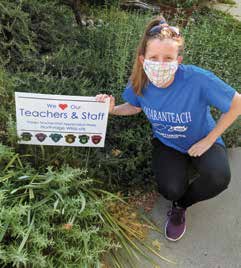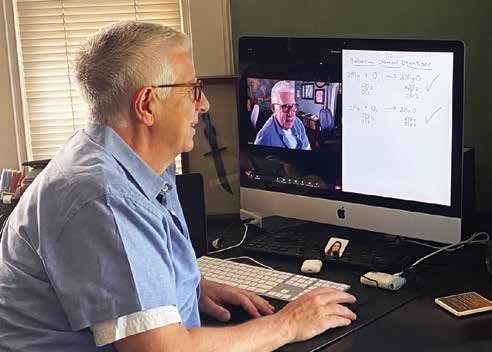Three public-school teachers who live in Curtis Park and normally commute to suburban districts want parents to realize that educators all know there’s nothing normal about the distance learning that became necessary in the COVID-19 pandemic.

Mary Durbrow of 26th Street has adjusted to distance-teaching 27 firstgraders in the San Juan Unified School District.
Will and Pam Carlton of Fourth Avenue teach in the Elk Grove Unified School District. Will teaches five classes of eighth-grade physical science. His average class size is 32. Pam teaches 28 fourth-graders.
For Mary, a “typical” school day now includes messaging parents with updates, plus trouble-shooting technical problems families may experience with the online platform. She checks work submissions from her students and either approves it for their journals or sends it back for revision if needed.
Mary plans, records and schedules lessons for each day of the following week. On some days, there are Zoom grade-level check-ins, staff meetings or district-provided training for distance learning professional development.
“I am using mostly online activities,” she says. “Students can take a photo of their work if they choose to do some of the items such as math problems or writing on paper at home.” But students don’t have their normal supplies at home – just their math workbooks and one other reading and writing book.
“Some kids seem to thrive with distance learning, but others really struggle with it,” Mary says.
She also notes there is a limit to how much screen time should be assigned to very young students.
She has heard from many parents how their kids miss school, their friends and teacher; they need to know those feelings are valid and important.
Teachers also miss “the sense of community in the classroom and on the school campus,” Mary says. That community feeling is hard to replicate online.
For parents, Mary recommends adherence to a schedule so students stay in school mode. “At the beginning of all of this, a few parents mentioned they were struggling because their kids felt summer had come early, and I think a schedule can really help with this.” Mary believes everyone should understand there will be gaps in some students’ learning when school resumes.
“As a community, I think we are going to need to think of unique ways to support students as we move forward next year,” she says. “I know we are going to need extra support and, when it is safe, possibly volunteers to help support students who might have fallen behind.” Will’s school day now often starts with emails, “putting out the little fires everywhere.” Many teens study late at night, so there are questions in the morning. He then moves into grading, provides feedback on current assignments, updates the grade book and contacts students about missing work.

“I don’t do Zoom lessons, as that forces an external schedule on students and parents,” Will says. He embeds into his lessons short instructional videos and screencasts that can be watched at any time and replayed as needed. He spends part of each day on curriculum design or re-design, and concludes the school day setting up the agenda and lessons for the following day.
“I think the toughest thing for all teachers right now is that we do not have the one-on-one that many students need,” Will says. “The structure of the classroom is essential for a lot of kids. I am actually very proud of how well my students have done.”
He urges parents to make sure their students are completing assignments by checking the school’s online grade book and their Google classroom. Especially with older students, Will suggests, “Give them the space to figure this out. They are learning a lot about individual discipline and organization through this process.”
Pam’s biggest challenge is student engagement. Many of her students are not doing the lessons or are settling for low or incomplete scores. She finds that younger students really need the direct contact with their teacher and classroom to maintain engagement and make progress.
The Carltons’ daughter Olivia is completing her senior year remotely at C.K. McClatchy High School. The family is grateful for the technology at their disposal, a strong Internet connection and space for all to concentrate.
Thanks to a garage remodel, Pam has an office and classroom. Will works in an office space within their home. Olivia finds a comfortable spot on the couch or in the recliner for using her laptop.
Will emphasizes that school districts were not prepared for the educational pivot to distance learning. Schools had to ensure all students had access to the curriculum. Because of the digital divide, few teachers use all of the available digital platforms.
“My science department of nine teachers share 70 Chromebooks total,” Will says. “If my classroom had been one-to-one, this transition would have been much easier.”
